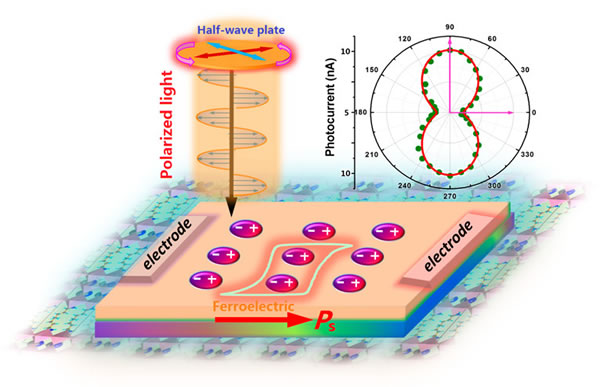
Two-dimensional (2D) materials such as graphene, black phosphorus, MoS2, etc. have become an important class of optoelectronic materials for assembling new optoelectronic devices. Polarized photodetectors formed based on the inherent structural anisotropy of 2D materials have been used in various fields from optical communications to the military. Recently, 2D layered hybrid perovskites have attracted widespread attention due to their unique physical and photoelectric properties. Structurally, this 2D hybrid perovskite exhibits unique compatibility and tunability; the electronic, optical, and optoelectronic properties of the material can be modulated by adjusting organic and inorganic components. More importantly, the organic cations in the 2D structure can achieve a very large degree of freedom of movement, providing a driving force for inducing ferroelectricity, and then the coupling of spontaneous polarization (Ps) and light is conducive to the separation of photo-generated carriers, making 2D hybrid Perovskite has become a competitive candidate for a new generation of photonic devices.
The team of Luo Junhua, a researcher of inorganic optoelectronic functional crystal materials at the State Key Laboratory of Structural Chemistry, Fujian Institute of Research on the Structure of Matter, Chinese Academy of Sciences With the support of the Youth Fund, the “Spring Miao Talents†project of the Chinese Academy of Sciences' Haixi Research Institute and the Fujian Provincial Outstanding Youth Fund, a case of two-dimensional double-layer hybrid perovskite ferroelectrics [CH3 (CH2) 3NH3] 2 (CH3NH3) Pb2Br7. The unique two-dimensional perovskite structure results in a significant anisotropy of its light absorption (the ratio αc / αa ≈ 1.9 at 405 nm), and at the same time, the strongest photoelectricity is observed along the c-axis (ie, parallel to Ps) Responsive, and has a large dichroic ratio (Iphc / Ipha ≈ 2.0) and a high sensitivity detection rate of up to ~ 109 Jones. In addition, its crystal devices show fast response rate (~ 20 μs) and excellent fatigue resistance. All these characteristics make it a potential candidate for short-wave polarized light detection, adding new functions to the application of organic-inorganic hybrid perovskites in future optoelectronic devices. The relevant results were published in the Journal of the American Chemical Society (J. Am. Chem. Soc., 2019, 141, 2623–2629). Associate researcher Li Lina was the first author of the paper.
YUHONG GROUP CO.,LIMITED , https://www.jessro-pipefittings.com
![<?echo $_SERVER['SERVER_NAME'];?>](/template/twentyseventeen/skin/images/header.jpg)